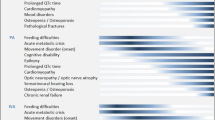Abstract
Renal function was evaluated in six patients with fetal alcohol syndrome (FAS) and eight control subjects before and after fluid restriction and acute acid loading. Baseline serum electrolytes, creatinine clearance, fractional sodium excretion, tubular reabsorption of phosphate, urine and blood pH and osmolalities, plasma renin activity, and plasma aldosterone level were normal in all subjects, but fractional potassium excretion (FEK) was lower in FAS patients than in control subjects (P<0.001). Despita equivalent plasma osmolalities (295±3 vs 293±2 mosmol/kg,P=0.2), the maximum urinary osmolality after 12 h of water deprivation in patients with FAS was significantly lower compared with controls (560±107 vs 965±77 mosmol/kg;P<0.001) and increased to only 578±101 mosmol/kg after vasopressin administration. After ammonium chloride loading, minimum urine pH was significantly higher in patients than in controls (5.7±0.17 vs 4.81±0.19;P<0.001). Net acid excretion and FEK were also lower in patients than in controls (102±11 vs 139.6±11.3 μEq/min per 1.73 m2 and 23.5±1.3 vs 29±1.6%, respectively;P<0.001). The data indicate a subclinical renal tubular defect in urine concentration and acidification in patients with FAS.
Similar content being viewed by others
References
Jones KL, Smith DW (1973) Recognition of the fetal alcohol syndrome in early infancy. Lancet II:999–1001
Clarren SK, Smith DW (1980) The fetal alcohol syndrome. N Engl J Med 298:1063–1067
Streissgurth AP, Landesman-Dawyer martin JC, Smith DW (1980) Teratogenic effects of alcohol in humans and laboratory animals. Science 209:353–361
Hansen JW, Jones KL, Smith DW (1976) Fetal alcohol syndrome: experience with 41 patients. JAMA 235: 1458–1460
Goetzman BW, Kagan J, Blankenship WJ (1975) Expansion of the fetal alcohol syndrome. Clin Res 23:100A
DeBeukelaer MM, Randall CL (1977) Renal anomalies in the fetal alcohol syndrome. J Pediatr 91:759–760
Qazi Q, Masakawa A, Milman D, McGann B, chua A, Haller J (1979) Renal anomalies in fetal alcohol syndrome. Pediatrics 63:886–889
Criteria Committee, National Council on Alcoholism (1972) Criteria for the diagnosis of alcoholism. Ann Intern Med 77:249–258
Edelmann CM Jr, Boichis H, Rodriguez-Soriano J, Stark H (1973) The renal response to children to acute ammonium chloride acidosis. Pediatr Res 1:452–460
Chan JCM (1972) The rapid determination of urinary titratable acid and ammonium and evaluation of freezing as a method of preservation. Clin Biochem 594–98
Berliner RW (1982) Mechanisms of urine concentration. Kidney Int 22:202–211
Tannen RL, Falls WE, Brackett NC (1975) Incomplete renal tubular acidosis: some clinical and physiological features. Nephron 15:111–113
Rector FC (1976) Renal acidification and ammonia production. In: Brenner BM, Rector FC Jr (eds) The kidney. Saunders, Philadelphia, pp 318–343
Stokes JB (1982) Ion transport by the cortical and outer medullary collecting tubule. Kidney Int 22:473–484
Assadi FK, Ziai M (1986) Zinc status of infants with fetal alcohol syndrome. Pediatr Res 20:551–554
Flynn A, Martier SS, Sokel RJ, Miller SI, Golden NL, DelVillano BC (1981) Zinc status of pregnant alcoholic women: a determinant of fetal outcome. Lancet I: 572–575
Keppen LD, Pysher T, Rennert OM (1985) Zic deficiency acts as a co-teratogen with alcohol in fetal alcohol syndrome. Pediatr Res 19:944–947
Author information
Authors and Affiliations
Rights and permissions
About this article
Cite this article
Assadi, F.K. Renal tubular dysfunction in fetal alcohol syndrome. Pediatr Nephrol 4, 48–51 (1990). https://doi.org/10.1007/BF00858439
Received:
Revised:
Accepted:
Issue Date:
DOI: https://doi.org/10.1007/BF00858439




